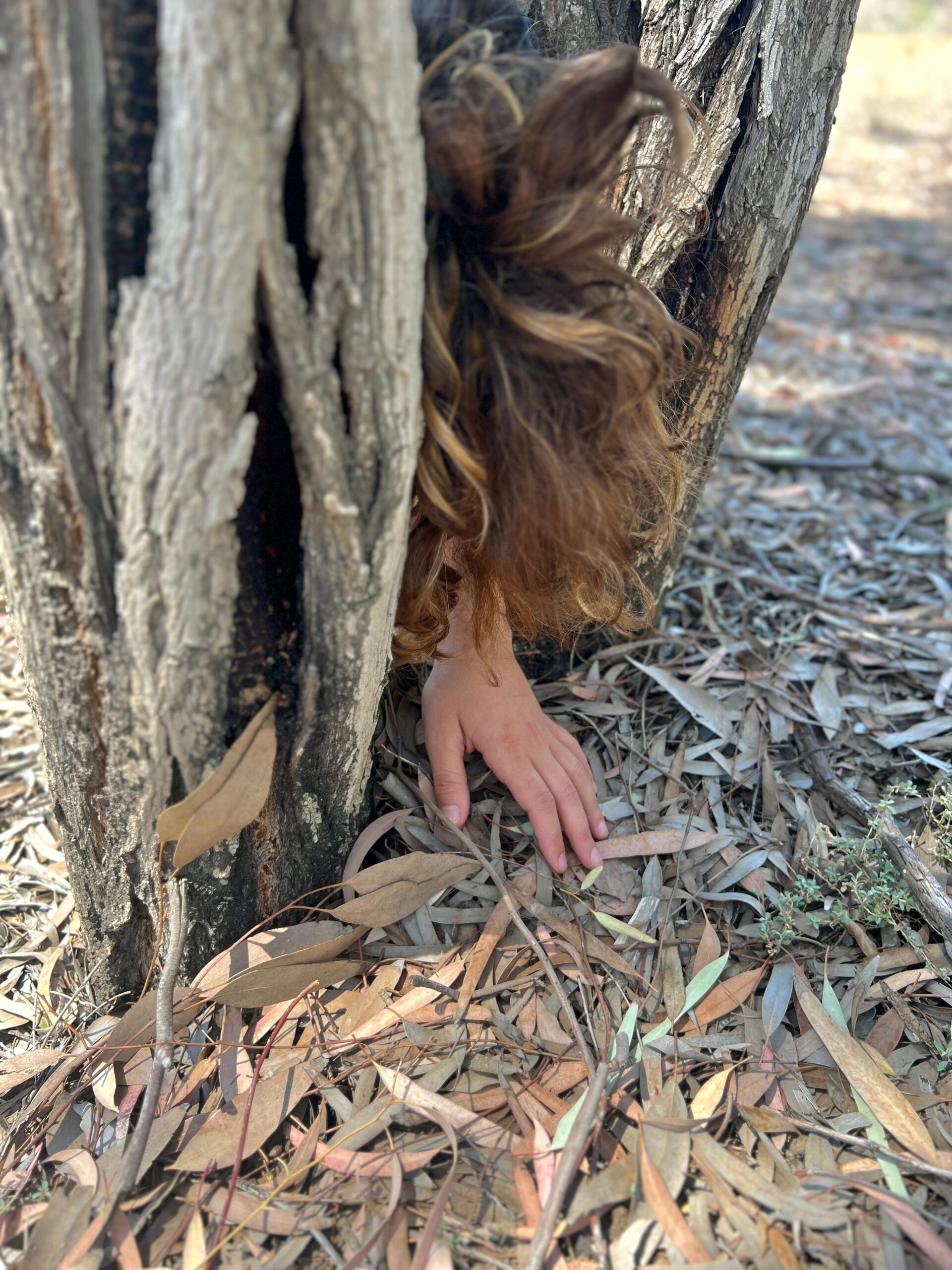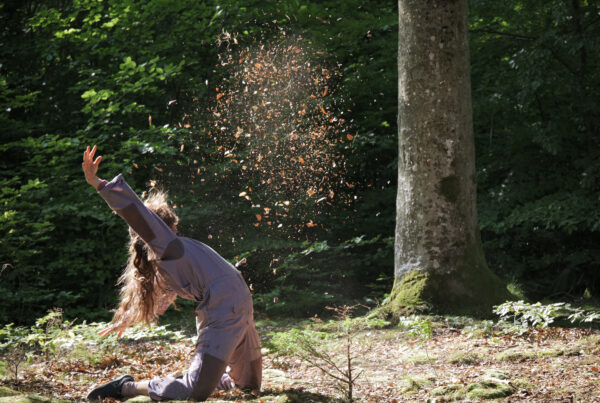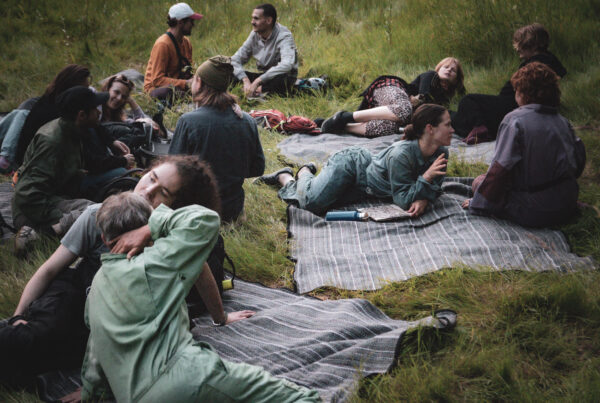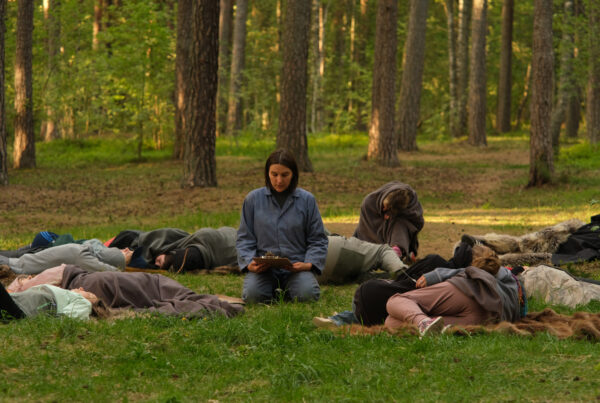Published 23.05.2025
Translated from Greek

Codirector Olive Bieringa shares some information about the paths they want the audience to “travel” through the participatory performance taking place in Athalassa Park.
A performance is being set up in Athalassa Park, inviting the audience to experience the environment and engage in an introspection of the lifestyle of the modern citizen, as part of the “On bodies” festival, which is taking place these days, until May 25, 2025.
The performers, Belinda Papavasiliou, Melissa Garcia Carro, Maria Papageorgiou, Ioli Kaskanis, Arianna Economou, Vasiliki Tsangari, Maria Lothe, Otto Ramstad and Olive Bieringa create the conditions to observe a participatory performance, so that the audience has the opportunity to observe, reflect on the ecological crisis and move collectively towards the creation of more ecologies of mutuality, but also practices to support life that survives through losses in a depleted and eroded land. For this participatory performance and what they are preparing for the audience, the creator at Olive Bieringa shares some details about the paths they want the audience to “travel”.
 The codirector Olive Bieringa. ©Maria Lothe
The codirector Olive Bieringa. ©Maria Lothe
Resisting Extinction. What does the title want to tell us? What are we resisting?
If we think about capitalism and what’s happening in Palestine and Israel, in Ukraine and Russia and in various parts of Africa… So many people are losing their lives, so many other organisms are being killed. And in fact, all over the planet, many species and organisms are dying, every day, so that other life can continue. Even if we look at this park [Athalassa], here in front of us, we see that organisms are dying, and that’s what makes the earth capable of “giving birth” to new life. So, I think, the title raises and maintains some questions.
For example: When does understanding the cycle of life and death allow us to understand and feel comfortable with death and grief? And when is death simply a wasted act, one that we turn our backs on and are not really willing to “sit” with? How is it possible to hold this discomfort about what is happening around us, and at the same time how do we learn and practice ways of grieving so that we can, in a way, process some of our emotions that are really difficult?
Other questions also arise, such as: what life is it that we support? Because there is our own entity, our self, but in reality we live in something larger or, more accurately: Our life is made possible by all these other beings. The trees, the plankton in the oceans are what make the oxygen we breathe. Then all these other resources that we need enter the equation – the food we eat, the clothes we wear, all of these come from this Earth. And yet, we are constantly stripping it of what it gives us, to the point where they can no longer exist. We are already in the sixth mass extinction wave.
So, how likely is it if we continue in the same way? Will we continue to exist as a human species or will we also follow the path to extinction? The question, then, is whether we can look this reality in the face: the extinction of not only many species, which is happening before our eyes, but also the potential extinction of humans themselves. So I think about what it is that we need to change the way we perceive where we are and to respect and to live ethically and sustainably in relation to what it would be like to come into contact with all these other beings. For me, that’s where the title comes from. Also, let’s say that towards the end, a physical experience also takes shape. In other words, the body itself is given the opportunity to feel that it is resisting extinction or to resist in general.
A performance that invites you to be present, to touch the ground, to observe the movement of trees, organisms, etc. The performance, however, is divided into 2 parts. In the first, it is rather an individual experience of the participant with one of the performers and then a group performance takes place. Why did you make this choice?
This is kind of like a welcome, a “hello.” However, at the same time this person is guiding you through this landscape and introducing you to all these other beautiful organisms that are here. And it’s kind of inviting you to spend time with them or to watch the performer spend time with them, helping you to “ground yourself,” in order to have a sensory experience of what this place is like, what the weather is like here. In this way, the experience evolves gradually, first you experience something more personal and then you move on to the second part which is a more open exploration. The audience, in the second part, wanders freely through the landscape. The performers are scattered throughout the space, “animating” the landscape with their presence, embodying in a non-representational way various endangered or even extinct creatures and beings that once lived here or that may still exist but are difficult to locate.
The audience is invited to develop a different perception of space, to imagine what this landscape was like when it was underwater, what existed here a hundred million years ago, who lived here a thousand or fifty years ago.
 ©Maria Lothe
©Maria Lothe
This place, Cyprus, was once an island full of trees, a green, lush landscape that is now turning into a desert. And in fact, people have cut down trees so many times to burn wood, to build things, to build ships, to mine metals; to harness the energy of trees. So the land has been worked very intensively. And yet, it is the land that saves lives in so many different ways. It’s incredible, isn’t it? Can you imagine all this history being here, in this land?
What has really happened here? It’s been reforested; it’s an artificial environment, in a sense. But it’s an environment that offers us so much. All these species come from the other side of the world, and yet they’re useful; they offer us a kind of support that makes our stay here more comfortable and enjoyable.
And then, in the last part of the project, it’s a practice, an experiential exercise around the concept of death and decomposition. So we lead people and ask them how they would like to practice dying. There are a few different options. And then we gather the participants somewhere and guide them through the natural process of “dying” either from dehydration or drowning. Their body, as it decomposes, is scattered across the landscape by various insects, animals, fungi, and so on.
How did you prepare for all this? Did you give any instructions to the performers?
Yes, we’ve been training and working together for a week now, only Maria, Otto and I have already done the project many times. Everyone else is new. So, yes, they’re trying to figure out what it’s all about. We’ve been working with a lot of material. And for me, this is a form of ecosomatic process, because we’re learning about ourselves and our own biology, but at the same time we’re also learning about this ecosystem. A bird expert came and talked to us about all the different species of birds here. A zoologist came and talked to us about the history of the earth and the different animals that have lived here.
 ©Maria Lothe
©Maria Lothe
We’ve also learned about fungi and we’ve realized that there are about 50 different species of eucalyptus here. So we’re actively engaging in all this scientific information, along with physical work with our bodies, to feel how our senses work and how the fluids circulate within us.
We are part of the lake cycle, we will drink water, we will urinate, and this water will end up back in the lake. This whole ecosystem also permeates us. All of this moves within us: we are made of carbon, water, calcium and other elements of nature. So we have a direct and deep relationship with all these other beings. We tried to feel this connection within ourselves.
 ©Maria Lothe
©Maria Lothe




